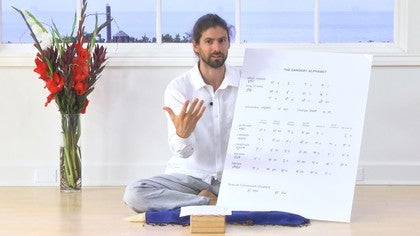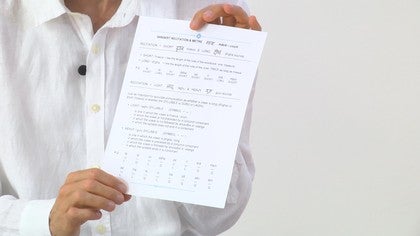Description
We have attached the Sanskrit Alphabet PDF for you to follow along with us. If you want to dive deeper into the Sanskrit Alphabet, we suggest checking out Mother Tongue.
About This Video
Transcript
Read Full Transcript
So, my teacher's father, Laxmita Dacharya, says, you know, you take a pandit from Kashmir in the north and Kerala in the south and really their pronunciation will be very, very close. And one of the main reasons for this is because we have this kind of clear guidance as to how the different sounds are formed. So basically, we have, in the Sanskrit alphabet, vowels and in the vowels there are short vowels and long vowels. We'll look at that in a moment. We have the anasvara and the visara, Gautja particular sounds, which behave differently a little bit in different situations.
We'll look at that. We have the semivowels, the sibilants, the nasals and the consonants. And then we have these couple of special consonant clusters which we're also going to look at. So starting with the vowels, first sound of the Sanskrit alphabet is basically the first sound we can possibly make. So you open your mouth and make a sound, this is kind of like the first sound.
So it's important to notice that sometimes, say, for example, we've studied Italian or Spanish and this is the Roman alphabet, we think a, like this harsh a sound, but it's nice, like a, which is more or less the first sound you can make when you open your mouth. And the second sound is a. So a, a. And the important thing here is to open the mouth. So one time I was with one of my young Sanskrit teachers who had been, you know, grown up with it from the cradle and we were reciting something together and he says to me at the end, he says, James, I'm from England, James, he says, is it rude to open the mouth when you speak in England?
Ah. So the idea is a and ah. And when we do open the mouth, it brings this lovely fullness to the sound. So ah and ah, ah, ah. Then we have ee, ee, ee, ee, ooh, ooh, ooh, ruh, ruh.
We won't need this long ruh sound, it won't crop up in the second chapter, but this is like ruh. And the thing to know about this is that this ruh vowel sound, it's like the tongue touches the roof of the mouth, ruh, ruh, ruh. Then we have the long vowels. Now as well as the ah, ee, ooh, ruh, there are these ones which are always long. So we can see we've got short uh and long ah.
Short ee and long ee. Short ooh and long ooh. Short ruh and long ruh. But ee, ee, ooh, ooh, they're kind of always long. So you might notice uh, ee, ooh, they're kind of quite brief sounds, they're kind of snappy sounds.
But ah, ee, ooh, ee, ee, ooh, ooh. We stay on that sound a little bit longer and this is an important thing when we're pronouncing Sanskrit to differentiate those sounds. So I'll do it one more time and if you'd like to you can repeat together. Ah, a, uh, a, a, ee, ee, ee, ooh, ooh, ruh, ruh, ruh, ruh, ah, ei, ei, ei. ei, ayi, ayi, oh, oh, ao, ao, and then we have anuswara and visarga, am, aha. I'm going to talk about these a little bit more in a few moments, but first we're going to do this section. For now, am, aha, and these behave in particular ways, depending what's kind of surrounding them, so we'll come to that later. So now coming to the consonants, now you'll notice that we have down this side, basically the place the sound is pronounced.
So the beautiful thing here is we've got a map or a guide as to where we kind of enunciate it from. So gutaros, which in the Sanskrit is kantya, it basically means from here in the throat. Palatals, a little bit higher. Cerebrals basically means that the tongue touches the palate, kind of like towards the rear of the hard palate, but before the soft palate. In other words, the tongue points up towards the brain and gently touches the top of the mouth. Dental, as the name suggests, the tongue is right on the teeth, even like this. So again, that Sanskrit teacher said to me, and in England, if you show your tongue, when you're speaking, is that a bad thing? Because for these dental sounds, you bring the tongue right to the teeth, and even, you can even bring it a little bit through and that's fine. We'll see that as we pronounce. Then labials on the lips. One of the things to be aware of here is that we have alpaprana and mahaprana. So I'll go through them first, and maybe you'll notice what's the difference, and then we'll kind of look at that a little bit more closely. So starting with the gutrals, we have k, k, k, k, g, g, g, g, g, g. Then the nasal gutral sound is like n, like in the English word bring, for example, or gang, is n. Then the palatals, ch, ch, ch, ch, ch, j, j, j, j, j. And the palatal nasal is nya, nya. The cerebrals, so this one, remember, the tongue is touching the top of the mouth, pointing up towards the brain, or pointing up, let's say, towards the middle of the brain, in the middle of the palate. So, t, t, t, t, t, t, t, t, t, t, nya. Then the dentals, this time the tongue comes all the way to the teeth, t, t, t, t, t, t, t, t, t, t, t, t, t, t, t, t, t, t, t, t, t, t, t, t, t, t, t, t, t, t, t, t, t, t, t, t, t, t, t, t, t, t, t, t, t, t, t, t, t, t, t, t, t, t, t, t, t, t, t, t, t, t, t. So you may Prana basically means life force or vital energy, but it's also used to refer to the life force or vital energy that moves through us, through the agency of the breath and then the circulatory system, but starting with the breath. So in this instance, alpa means a little or a small amount, and maha means great or a large great amount. So basically, alpa prana means using less breath and maha prana means using more breath. In other words, this is an aspirated sound, the maha prana, and the alpa prana is an unaspirated sound. So let's just look at the difference there.
So for example, k and k, maybe you can hear the difference, a little bit more breath. Now it's not that we have to say k and k, more subtle than that. One way you can feel it quite nicely, let's take the example of a dental. Let's take, for example, duh and duh. So there's a Sanskrit word, dhana, with a d like this, dhana, and it means giving or charity.
So if you say dhana, with the tongue coming close to the teeth, dhana, and you put your hand in front of your mouth, dhana, feel what it's like with the hand in front of the mouth. Then if we say tarma, which uses the maha prana, dh, sound, tarma, maybe you'll feel there's a kind of a little soft explosion of breath onto your hand, tarma, tarma. So you can feel that little bit more breath coming out, and that's the difference. So it's significant enough that once you train your ear to it, you can hear it, dhana, dharma, kala, kyapa, for example. You can hear this little bit more breath.
So this is alpa prana and maha prana, and when you're working from a transliterated document, the maha prana is indicated by this h after the consonant sign. And if you see that h after the consonant sign, this is the symbol for maha prana in the transliterated Roman form. Now the nasals, I already mentioned a couple of them. The nasals, as the name suggests, involve this pronunciation through the nostrils, and it depends also where we're pronouncing from. So we have n, ny, ny, ny, and m.
Now I mentioned earlier that the anuswara behaves differently in different situations. So sometimes at the end of a word, you'll see an m with a dot. Now this m with a dot doesn't necessarily mean m. Same with a dot, if it's at the end of a line, it will definitely mean m. But if it's in the middle of a line, its pronunciation might actually be one of these.
So the anuswara at the end of a line means m, which is the kind of closing nasal sound. It's the sound we make when we close our mouth, m, m. Say, for example, we were going to say a word beginning with n, after a word ending with m with a dot. For example, om. We could transliterate om, an o, and an m with a dot.
Let's say we wanted to then say, nama shivaya. We wouldn't say om, nama shivaya, if it was speaking quickly, we'd say om nama shivaya. So this m with a dot transforms into the nasal of the same class, the same group, as the sound that follows it. So for example, om nama shivaya, n is a dental. So we say, om nama shivaya.
If we say, for example, om, gom, ganapatayinamaha, then g is a guttural sound. And so we'll say, om ganapatayinamaha, om ganapatayinamaha. And so basically this just makes it easier to pronounce more fluidly, but it still maintains the clarity that we can identify there is that nasal sound, there is the anuswara. Another example, the beginning of the well-known Gayatri mantra, om bhoor bhuvaswaha. This is a labial sound, bhoor.
So the anuswara will be pronounced as ma, om bhoor bhuvaswaha, om nama shivaya, om ganapatayinamaha, in the guttural. So when you see the M with a dot at the end of a line, ma, but in the middle of a line, it can be pronounced in different ways, depending what comes after. So if the word that comes after is a powerful sound, the M with a dot will be pronounced more like this. If it's a guttural sound, it will be pronounced like this. As well as these consonants, we have these special classes of sound, the semivowels, yerlava, and yer, er, ler, er.
They're represented in the Roman transliteration with y, r, l, v, but they're not exactly corresponding to these sounds. So yer, it's a semivowel. One way we can think of it to help us is it's the combination of e and a. So if you say e and a together, you get yer. R, similar to this vowel, is pronounced with the tongue, like a cerebral sound.
Coming up, you can see here it's in the cerebral line, the tongue touches the roof of the mouth, r, r, and it moves forward as it makes that r, just a little bit, r, l. Now this one is perhaps the one that's furthest from what the Roman transliteration might suggest. So if we see the word, we see the letter v, we think of like v, very. But the Sanskrit sound isn't as harsh as that. So if you think of the sound u and the sound a, and then say them quickly together, u, a, ua.
So it's not v, and it's not like a w, either. It's not w. It's somewhere in between, w, like shiva, so it's not as harsh as the English v. We have h, and then we have these three sibilant sounds, sh, which is the sh of shiva, for example, sh, which is the sh of, for example, upanishad, or krishna, and then sa, sadaswati, so sh, sh, sa. What's the difference between this first sh and this second sh, the place of pronunciation?
So this one with the dot, again, the tongue comes through with the mouth, so sh, so an example of that is krishna, shiva, krishna, sadaswati, and as well as all these sounds, one feature of Sanskrit is that we sometimes combine sounds. There are many conjunct consonants where we have different consonants together, but there are also these special consonant clusters, and this is ksh, ksh, and nnya, nnya, and this nnya, sometimes people pronounce it in ways because it's based on non-standard transliteration, but this is basically the combination of the j and the nnya here, and this is the beginning of the word, for example, nnyana, nnyana, so ksh, ksh, and nnya, nnya. So that's a little bit about the alphabet. One more thing we haven't mentioned yet is visarga. Now the visarga behaves in different ways in different places.
Generally speaking, if it's at the end of a line, there's a kind of echo of the vowel sound which precedes it, like aha, or if it was i, before the H with a dot, it would be ihi, and this one, when we do the recitation, we'll see this more in context, and we'll see the different ways it behaves, so I'll talk more about that when we've got the actual context of the verses to support us. Now before we move on to that, we'll just go through these sounds once more, call and response. So going through the whole alphabet now, just with the sounds, call and response, I'll say it once, and then a second time, replicating the sound, a, a, a, a, i, i, i, i, u, u, u, r, r, r, r, a, a, i, i, o, o, ow, ow, um, um, aha, aha, e, e, e, c, c, c, c, c, c, g, g, g, g k, n, n, ha, ha, cha, actor, cha, cha, cha cha cha cha cha nya nya ya ya sha sha remember now the tongue to the top of the mouth tah tah tah dah dah tah tah nah nah rah rah sha sha and now with the tongue to the teeth tah tah tah tah dah dah tah tah nah nah lah lah sha sha then the labial pah pah pah bah bah pah mah mah rah rah ksha ksha nya nya and this will make a lot more sense once we start to experience it in context
The Song of Self: Let's Recite
Comments
You need to be a subscriber to post a comment.
Please Log In or Create an Account to start your free trial.









